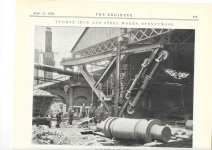I'm afraid I haven't presented the best picture for scrutiny, my scanning/uploading lacks finesse , looking at the original with a lens gives a few clues.
I think you can see a diagonal rope leaving the smaller inclined cylinder from the fixed sheave towards the lower swing bearing, this must be single acting and matched the other side for slewing?
The two vertical cylinders both run up to the right place on the jib to be powering the traverse ,one pulling either way.
Water -hydraulic of course, not sure if they ever added oil? Next door here we had a factory running remote water and oil accumulator systems for press work and running lifts(hoist).
The high pressure system was multiplied up to power Henry Berry (Leeds)filter presses. I think the system ran at 10,000psi, the presses had 9" cylinders, pressing cellulose through fine brass gauze with filter cloth over them, I think the press cylinder ran at 15,000psi.
The water system ran at much lower pressure with lots of "old fashioned" fits, leaks and much of the system direct to waste.A friend of mine worked there from the early '60s, maybe '63 was a cold winter, the water accumulator drive pipe froze one night between shifts, when they started fiddling to workout what was the problem it blew the frozen fitting off together with a plug of ice, the tank fell to the ground showering freezing water, landed on the railway sleeper (ties?)table used to rest the tank on when down. The tank held 30tons of sand and was made of 5/8" rolled plate, all bolted up with 5/8 Bolts. As the tank landed each row of bolts sheared in turn,
leaving a kit form accumulator. As my mate tells the story the whole place shook, windows broken ,etc. Funny really, 130 yrs of working with nitro-cellulose and similar and the biggest bang was a tank full of sand!
Richard



